Overview
- Brief Narrative
- Courtroom drawing created by Charles (Hap) Hazard while on assignment for the Baltimore Sun newspaper during the 1979 deportation trial of Karlis Detlavs held in Baltimore, Maryland. It depicts eyewitness Frida Michelson testifying that Detlavs was the guard who forced her to the execution pit during the massacre in the Rumbula Forest in December 1941. Michelson survived by hiding under a pile of discarded shoes. She identified Detlavs from a 1941 photo shown to her by Israeli police in the 1970s, but did not identify him in person at the trial. Detlavs was accused of withholding information on his petition for permanent residency by denying involvement in Nazi war crimes during World War II (1939-1945). He was accused of executing Jews in the Riga ghetto and selecting Jews for execution in the Dwinsk ghetto in 1943, while a member of the Latvian Auxiliary Security Police during the German occupation. In 1950, Detlavs emigrated from Munich, Germany, as displaced refugee, with his pregnant wife and young daughter. The family immigrated to the United States and settled in Baltimore. In October 1976, the Office of Special Investigations, US Department of Justice, accused Detlavs of war crimes and the US Immigration and Naturalization Service (INS) filed a deportation action. In November 1977, after four days of hearings, the Honorable Martin J. Travers, the federal immigration judge for the case at the time, announced a continuance so the prosecution could obtain more evidence from Soviet sources. In June 1978, while Judge Travers was on assignment in the US Virgin Islands, part of his circuit at the time, he was stabbed to death. New hearings in the Detlavs trial were held in November 1978 and January 1979. While Detlavs admitted being a member of the Latvian Legion, he denied committing any crimes. Judge Emil Bobek denounced Detlavs for his lack of credibility, but ruled that the identification of Detlavs as a perpetrator was not reliable and a lie was not enough to warrant deportation. The ruling was upheld on appeal.
- Artwork Title
- Frida Michelson Testifying in the Trial of Karlis Detlavs
- Series Title
- Karlis Detlavs Trial, Baltimore, Maryland, 1977-1979
- Date
-
creation:
1979 January
- Geography
-
creation:
Baltimore (Md.)
- Credit Line
- United States Holocaust Memorial Museum Collection, Gift of Charles R. Hazard and The Baltimore Sun
- Signature
- front, bottom right, black ink : ‘79 / C. HAZARD
- Contributor
-
Artist:
Charles R. Hazard
Subject: Charles R. Hazard
Subject: Karlis Detlavs
- Biography
-
Charles Rodger Hazard (Hap, 1947-2018) was born to Charles O. and Stella Dernoga Hazard in Baltimore, Maryland. His father served in the United States (US) Army during World War II (1939-1945). He worked as a topographical engineer for British Intelligence, mapping the French coastline in preparation for the D-Day landings, and was later transferred to the Pacific theater. After the war, he worked in the advertising art department for the Baltimore Sun. Charles’ mother, Stella, worked at the Sun during the war as the first female staff artist. Charles’ sister, Carla Tomaszewski, also worked as a professional artist.
After graduating from high school in 1965, Charles enrolled at the Maryland Institute College of Art (MICA). However, due to the conflict in Vietnam, he enlisted in the US Army and was assigned to military intelligence because of his gift for languages. In 1968, prior to his deployment overseas, Charles married Miriam Deborah Wolfe. Upon his return in 1969, he began his work as a political illustrator for the Baltimore Sun newspapers. During a career that spanned more than 30 years, Charles created illustrations and court room drawings of memorable historical and political events for the newspaper. Charles and Miriam had four children. After retiring from the Sun, Charles worked as an editorial artist for the Washington Times newspaper. The National Park Service commissioned Charles to provide illustrations for numerous national landmarks. He came out of retirement to create fourteen illustrations of scenes from the Battle of Gettysburg for background murals on display at the Museum and Visitor Center at Gettysburg National Military Park, which opened in 2008.
Karlis Detlavs (1911-1983) was born in Latvia. In August 1940, during World War II (1939-1945), the Soviet Union occupied and annexed Latvia. Germany invaded Soviet territories in June 1941, and in July occupied Latvia, which became part of the Reich Commissariat Ostland, a German civilian administration for the Baltic States and western Belorussia. In 1941, Latvia had about 94,000 Jews, half of whom lived in Riga. During the German occupation, German Einsatzgruppen [mobile killing units], assisted by Latvian and Lithuanian auxiliary units, massacred most Latvian Jews. Detlavs was a member of the Latvian Auxiliary Security Police and the Latvian Legion, whose members wore German SS uniforms. World War II ended in Europe with the surrender of Germany in early May1945.
In June 1943, Karlis had married in Riga. In December 1950, Detlavs immigrated to the United States from Munich, Germany, as a displaced person with his wife, who was pregnant, and their almost two-year-old daughter, Marita. He told US officials that he had been a forestry worker during the war. The family settled in Baltimore, Maryland, where Detlavs worked for General Electric in an insulated cable factory. He never became a US citizen. His wife passed away, and Detlavs later married Vera. In 1973, he lost a leg due to cancer. After 23 years at the factory, Detlavs retired.
In October 1976, Karlis Detlavs was accused of war crimes and the US Immigration and Naturalization Service (INS) filed a deportation action. Beginning November 1977, Detlavs was tried in federal court for withholding information and denying involvement in Nazi war crimes upon becoming a permanent resident of the US in 1950. He was accused of the execution of Jews in the Riga ghetto and selecting Jews for execution in the Dwinsk ghetto. After four days of hearings, the judge, the Honorable Martin J. Travers, announced a continuance to permit the prosecution, led by INS attorney James Grable, to obtain more evidence from Soviet sources. Several members of the Jewish Defense League (JDL) attending the hearing staged what some newspapers described as a riot in the courtroom. They began shouting at the judge and were removed from the courtroom. In June 1978, while Judge Travers was on assignment in the US Virgin Islands, part of his circuit at the time, he was stabbed to death.
New hearings were scheduled for November 1978, and the judge, the Honorable Emil Bobek, discounted all testimony from the first trial. There were four days of testimony in November 1978 and four in January 1979. George L. Parker was the chief prosecutor. Deltavs was charged with lying on both his visa and his residency applications, and accused of participating in war crimes. When interviewed by US officials in Munich for immigration purposes, Detlavs told them that he had been a forestry worker during the war. During the trial, several eyewitnesses were brought to testify to Detlavs identity. Boris Tsesvan identified Detlavs as one of the uniformed guards who beat and took away another Jewish forced laborer from the Hotel Roma in Riga in June 1943. Abraham Lipchin identified Detlavs as one of a group of Latvian police officers shooting Jews in what became known as Bloody Sunday, on November 30, 1941.
Another witness, Frida Michelson, a 72-year-old Soviet emigre that had settled in Israel, identified Detlavs from a 1950 photograph shown to her in the late 1970s by Israeli police. She said he was the green-uniformed Nazi collaborator whom she begged for her life during the massacre at Rumbula forest on December 8, 1941. More than 30,000 Jews were murdered in two days during the Rumbula Massacre. She said he responded by knocking her documents from his hand with his fist. Someone else hit her on the head from behind. Detlavs then ordered her to remove her clothes, leave her belongings in designated piles, and forced her, with hundreds of other Latvian Jews, to an execution ditch. She threw herself in the snow and the other prisoners threw their shoes on her, quickly hiding her beneath a pile. She was hidden beneath the shoes when the group was machine-gunned. She stayed hidden until night fall and was the only survivor. Frida and other witnesses identified Detlavs from photographs of Latvian guards taken at the time, though she never identified Detlavs in the courtroom.
Detlavs admitted being forced by the Germans into joining the Latvian Legion, but denied any participation in beatings or mass executions in and around Riga during the early 1940s. In making his ruling, Judge Bobek admonished Detlavs for his lack of credibility and for lying under oath multiple times. However, he ruled that after 37 years, the identifications of Detlavs were unreliable, and the witnesses may have been influenced by Israeli police. The identification photo used by the witnesses was part of Detlavs' 1950 immigration application, and clearly showed one of his eyes, blinded in 1943, askew. The judge noted that the witnesses had all said the photo looked just like the man they had seen assaulting Jews in 1941, and did not mention Detlavs' eyes at all. Judge Bobek also said that the admitted lie was not sufficient to warrant deportation. In March 1980, the US Department of Justice appealed Bobek’s decision. The decision was upheld on appeal in 1981.
Physical Details
- Language
- English
- Classification
-
Art
- Category
-
Drawings
- Object Type
-
Courtroom art (lcsh)
- Genre/Form
- Courtroom sketches.
- Physical Description
- Black ink drawing on paper depicting a seated older woman in right profile with short, graying hair, a pronounced nose, and deep lines around her mouth, wearing a dark top and light scarf, with a microphone on her top. She is turned to the right with raised hands, looking toward a woman. This woman's head with thick, wavy hair is portrayed in right profile. At the top center, there are eight lines of text and white paint. The artist's signature and date are at the bottom right. On the reverse are an inscription, sketch marks, and a blue ink time stamp. The paper has adhesive residue and an uneven right edge.
- Dimensions
- overall: Height: 11.625 inches (29.528 cm) | Width: 10.125 inches (25.718 cm)
- Materials
- overall : paper, ink, graphite, adhesive
- Inscription
- front, top center, cursive, black ink : Frieda [Frida] Michelson - / (TESTIFYING IN THE / TRIAL OF CARLIS DETLAVS) / Her and another woman were the only / 2 survivors of the Nazi massacre of Jewish / residents, of the Riga Ghetto, in the Rambulu / woods. Others going to their deaths threw their / shoes and clothes on top of her to conceal her / from the Nazis. / She thought Detlavs was one / of the group of executioners.
front, upper right, handwritten, pencil : 55.5 [crossed through] / 26.5
back, top center, handwritten, black ink : George Parker / 425 I ST [crossed through] / 61 G St. / Wash. D.C.
back, right center, off the edge, stamped, blue ink : [?] PM 7 : 04
Rights & Restrictions
- Conditions on Access
- No restrictions on access
- Conditions on Use
- No restrictions on use
Keywords & Subjects
- Topical Term
- Courtroom artists--United States--Baltimore--Biography. Judges--United States. United States--Emigration and immigration. Holocaust, Jewish (1939-1945)--Latvia. War criminals--Government policy--United States--Biography. War crime trials--United States--Baltimore--Biography. World War, 1939-1945--Collaborationists--Latvia. Rumbula Massacre, Rumbula, Latvia, 1941.
- Geographic Name
- Latvia. Rīga (Latvia) United States. Baltimore (Md.)
- Corporate Name
- United States. Immigration and Naturalization Service
Administrative Notes
- Legal Status
- Permanent Collection
- Provenance
- The drawing was donated to the United States Holocaust Memorial Museum in 1989 by Charles R. Hazard and the Baltimore Sun newspaper.
- Funding Note
- The cataloging of this artifact has been supported by a grant from the Conference on Jewish Material Claims Against Germany.
- Record last modified:
- 2024-04-29 07:55:54
- This page:
- https://collections.ushmm.org/search/catalog/irn1167
Download & Licensing
In-Person Research
- By Appointment
- Request 21 Days in Advance of Visit
- Plan a Research Visit
- Request to See This Object
Contact Us
Also in Charles R. Hazard and The Baltimore Sun collection
The collection consists of fifteen courtroom sketches created by Charles R. Hazard for the Baltimore Sun newspaper during the postwar deportation trials of Karlis Detlavs and George Theodorovich in Baltimore, Maryland, for withholding information about their involvement with war crimes in Eastern Europe during World War II.
Date: 1977-1985
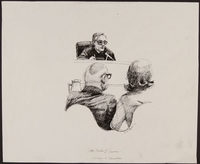
Drawing of judge speaking to defendant, an accused Latvian war criminal
Object
Courtroom drawing created by Charles (Hap) Hazard while on assignment for the Baltimore Sun newspaper during the November 1977 deportation trial of Karlis Detlavs held in Baltimore, Maryland. It depicts Detlavs, his daughter, and the Honorable Martin J. Travers, a federal immigration judge for the United States Immigration and Naturalization Service (INS). Detlavs was accused of withholding information on his petition for permanent residency by denying involvement in Nazi war crimes during World War II (1939-1945). He was accused of executing Jews in the Riga ghetto and selecting Jews for execution in the Dwinsk ghetto in 1943, while a member of the Latvian Auxiliary Security Police during the German occupation. In 1950, Detlavs emigrated from Munich, Germany, as displaced refugee, with his pregnant wife and young daughter. The family immigrated to the US and settled in Baltimore. In October 1976, the Office of Special Investigations, US Department of Justice, accused Detlavs of war crimes and the INS filed a deportation action. After four days of hearings, Judge Travers announced a continuance so the prosecution could obtain more evidence from Soviet sources. In June 1978, while Judge Travers was on assignment in the US Virgin Islands, part of his circuit at the time, he was stabbed to death. New hearings in the Detlavs trial were held in November 1978 and January 1979. While Detlavs admitted being a member of the Latvian Legion, he denied committing any crimes. Judge Emil Bobek denounced Detlavs for his lack of credibility, but ruled that the identification of Detlavs as a perpetrator was not reliable and a lie was not enough to warrant deportation. The ruling was upheld on appeal.
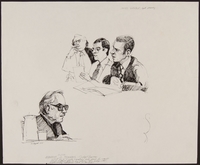
Drawing of judge and US attorney at trial of accused Latvian war criminal
Object
Courtroom drawing created by Charles (Hap) Hazard while on assignment for the Baltimore Sun newspaper during the November 1977 deportation trial of Karlis Detlavs held in Baltimore, Maryland. It depicts the Honorable Martin J. Travers, a federal immigration judge for the United States Immigration and Naturalization Service (INS), and three federal attorneys for the prosecution, including lead INS attorney James Grable. Detlavs was accused of withholding information on his petition for permanent residency by denying involvement in Nazi war crimes during World War II (1939-1945). He was accused of executing Jews in the Riga ghetto and selecting Jews for execution in the Dwinsk ghetto in 1943, while a member of the Latvian Auxiliary Security Police during the German occupation. In 1950, Detlavs emigrated from Munich, Germany, as displaced refugee, with his pregnant wife and young daughter. The family immigrated to the US and settled in Baltimore. In October 1976, the Office of Special Investigations, US Department of Justice, accused Detlavs of war crimes and the INS filed a deportation action. After four days of hearings, Judge Travers announced a continuance so the prosecution could obtain more evidence from Soviet sources. In June 1978, while Judge Travers was on assignment in the US Virgin Islands, part of his circuit at the time, he was stabbed to death. New hearings in the Detlavs trial were held in November 1978 and January 1979. While Detlavs admitted being a member of the Latvian Legion, he denied committing any crimes. Judge Emil Bobek denounced Detlavs for his lack of credibility, but ruled that the identification of Detlavs as a perpetrator was not reliable and a lie was not enough to warrant deportation. The ruling was upheld on appeal.
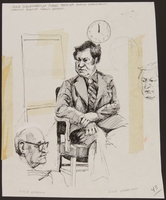
Drawing of a Holocaust survivor tesifying at trial of accused Latvian war criminal
Object
Courtroom drawing created by Charles (Hap) Hazard while on assignment for the Baltimore Sun newspaper during the November 1977 deportation trial of Karlis Detlavs held in Baltimore, Maryland. It depicts It depicts Jacob Wagenheim, a Holocaust survivor and witness, testifying about Detlavs involvement, and the Yiddish interpreter, Moses Aberbach. Detlavs was accused of withholding information on his petition for permanent residency by denying involvement in Nazi war crimes during World War II (1939-1945). He was accused of executing Jews in the Riga ghetto and selecting Jews for execution in the Dwinsk ghetto in 1943, while a member of the Latvian Auxiliary Security Police during the German occupation. In 1950, Detlavs emigrated from Munich, Germany, as displaced refugee, with his pregnant wife and young daughter. The family immigrated to the United States and settled in Baltimore. In October 1976, the Office of Special Investigations, US Department of Justice, accused Detlavs of war crimes and the US Immigration and Naturalization Service (INS) filed a deportation action. After four days of hearings, the Honorable Martin J. Travers, the federal immigration judge for the case, announced a continuance so the prosecution could obtain more evidence from Soviet Sources. In June 1978, while Judge Travers was on assignment in the US Virgin Islands, part of his circuit at the time, he was stabbed to death. New hearings in the Detlavs trial were held in November 1978 and January 1979. While Detlavs admitted being a member of the Latvian Legion, he denied committing any crimes. Judge Emil Bobek denounced Detlavs for his lack of credibility, but ruled that the identification of Detlavs as a perpetrator was not reliable and a lie was not enough to warrant deportation. The ruling was upheld on appeal.
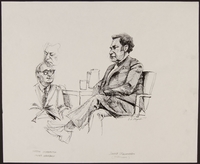
Drawing of eyewitness and interpreter at trial of accused Latvian war criminal
Object
Courtroom drawing created by Charles (Hap) Hazard while on assignment for the Baltimore Sun newspaper during the November 1977 deportation trial of Karlis Detlavs held in Baltimore, Maryland. It depicts It depicts Jacob Wagenheim, a Holocaust survivor and witness, testifying about Detlavs involvement, and the Yiddish interpreter, Moses Aberbach. Detlavs was accused of withholding information on his petition for permanent residency by denying involvement in Nazi war crimes during World War II (1939-1945). He was accused of executing Jews in the Riga ghetto and selecting Jews for execution in the Dwinsk ghetto in 1943, while a member of the Latvian Auxiliary Security Police during the German occupation. In 1950, Detlavs emigrated from Munich, Germany, as displaced refugee, with his pregnant wife and young daughter. The family immigrated to the United States and settled in Baltimore. In October 1976, the Office of Special Investigations, US Department of Justice, accused Detlavs of war crimes and the US Immigration and Naturalization Service (INS) filed a deportation action. After four days of hearings, the Honorable Martin J. Travers, the federal immigration judge for the case, announced a continuance so the prosecution could obtain more evidence from Soviet sources. In June 1978, while Judge Travers was on assignment in the US Virgin Islands, part of his circuit at the time, he was stabbed to death. New hearings in the Detlavs trial were held in November 1978 and January 1979. While Detlavs admitted being a member of the Latvian Legion, he denied committing any crimes. Judge Emil Bobek denounced Detlavs for his lack of credibility, but ruled that the identification of Detlavs as a perpetrator was not reliable and a lie was not enough to warrant deportation. The ruling was upheld on appeal.
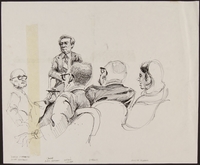
Drawing of accuser and accused at trial of suspected Latvian war criminal
Object
Courtroom drawing created by Charles (Hap) Hazard while on assignment for the Baltimore Sun newspaper during the November 1977 deportation trial of Karlis Detlavs held in Baltimore, Maryland. It depicts Detlavs, his daughter, and their attorney, looking at Holocaust survivor and prosecution witness, Boris Tsesvan, and Yiddish interpreter, Moses Aberbach. Tsesvan identified Detlavs as one of the uniformed guards who beat and took away another Jewish forced laborer from the Hotel Roma in Riga, Latvia, in June 1943. Detlavs was accused of withholding information on his petition for permanent residency by denying involvement in Nazi war crimes during World War II (1939-1945). He was accused of executing Jews in the Riga ghetto and selecting Jews for execution in the Dwinsk ghetto in 1943, while a member of the Latvian Auxiliary Security Police during the German occupation. In 1950, Detlavs emigrated from Munich, Germany, as displaced refugee, with his pregnant wife and young daughter. The family immigrated to the United States and settled in Baltimore. In October 1976, the Office of Special Investigations, US Department of Justice, accused Detlavs of war crimes and the US Immigration and Naturalization Service (INS) filed a deportation action. After four days of hearings, the Honorable Martin J. Travers, the federal immigration judge for the case, announced a continuance so the prosecution could obtain more evidence from Soviet sources. In June 1978, while Judge Travers was on assignment in the US Virgin Islands, part of his circuit at the time, he was stabbed to death. New hearings in the Detlavs trial were held in November 1978 and January 1979. While Detlavs admitted being a member of the Latvian Legion, he denied committing any crimes. Judge Emil Bobek denounced Detlavs for his lack of credibility, but ruled that the identification of Detlavs as a perpetrator was not reliable and a lie was not enough to warrant deportation. The ruling was upheld on appeal.
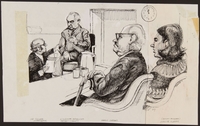
Drawing of eyewitness identifying defendant at trial of Latvian war criminal
Object
Courtroom drawing created by Charles (Hap) Hazard while on assignment for the Baltimore Sun newspaper during the November 1977 deportation trial of Karlis Detlavs held in Baltimore, Maryland. It depicts Detlavs and his daughter looking at the Yiddish interpreter, Mr. Smolar, and a Holocaust survivor and witness for the prosecution. Detlavs was accused of withholding information on his petition for permanent residency by denying involvement in Nazi war crimes during World War II (1939-1945). He was accused of executing Jews in the Riga ghetto and selecting Jews for execution in the Dwinsk ghetto in 1943, while a member of the Latvian Auxiliary Security Police during the German occupation. In 1950, Detlavs emigrated from Munich, Germany, as displaced refugee, with his pregnant wife and young daughter. The family immigrated to the United States and settled in Baltimore. In October 1976, the Office of Special Investigations, US Department of Justice, accused Detlavs of war crimes and the US Immigration and Naturalization Service (INS) filed a deportation action. After four days of hearings, the Honorable Martin J. Travers, the federal immigration judge for the case, announced a continuance so the prosecution could obtain more evidence from Soviet sources. In June 1978, while Judge Travers was on assignment in the US Virgin Islands, part of his circuit at the time, he was stabbed to death. New hearings in the Detlavs trial were held in November 1978 and January 1979. While Detlavs admitted being a member of the Latvian Legion, he denied committing any crimes. Judge Emil Bobek denounced Detlavs for his lack of credibility, but ruled that the identification of Detlavs as a perpetrator was not reliable and a lie was not enough to warrant deportation. The ruling was upheld on appeal.
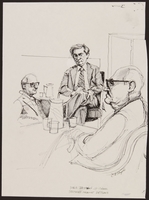
Drawing of Holocaust survivor testifying at trial of suspected Latvian war criminal
Object
Courtroom drawing created by Charles (Hap) Hazard while on assignment for the Baltimore Sun newspaper during the November 1977 deportation trial of Karlis Detlavs held in Baltimore, Maryland. It depicts Detlavs, Holocaust survivor and prosecution witness, Boris Tsesvan, and Yiddish interpreter, Moses Aberbach. Tsesvan identified Detlavs as one of the uniformed guards who beat and took away another Jewish forced laborer from the Hotel Roma in Riga, Latvia, in June 1943. Detlavs was accused of withholding information on his petition for permanent residency by denying involvement in Nazi war crimes during World War II (1939-1945). He was accused of executing Jews in the Riga ghetto and selecting Jews for execution in the Dwinsk ghetto in 1943, while a member of the Latvian Auxiliary Security Police during the German occupation. In 1950, Detlavs emigrated from Munich, Germany, as displaced refugee, with his pregnant wife and young daughter. The family immigrated to the United States and settled in Baltimore. In October 1976, the Office of Special Investigations, US Department of Justice, accused Detlavs of war crimes and the US Immigration and Naturalization Service (INS) filed a deportation action. After four days of hearings, the Honorable Martin J. Travers, the federal immigration judge for the case, announced a continuance so the prosecution could obtain more evidence from Soviet sources. In June 1978, while Judge Travers was on assignment in the US Virgin Islands, part of his circuit at the time, he was stabbed to death. New hearings in the Detlavs trial were held in November 1978 and January 1979. While Detlavs admitted being a member of the Latvian Legion, he denied committing any crimes. Judge Emil Bobek denounced Detlavs for his lack of credibility, but ruled that the identification of Detlavs as a perpetrator was not reliable and a lie was not enough to warrant deportation. The ruling was upheld on appeal.
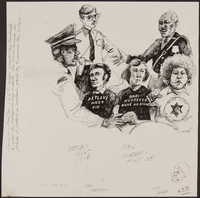
Drawing of guards and JDL protestors at trial of suspected Latvian war criminal
Object
Courtroom drawing created by Charles (Hap) Hazard while on assignment for the Baltimore Sun newspaper during the November 1977 deportation trial of Karlis Detlavs held in Baltimore, Maryland. It depicts three courtroom officers approaching three Jewish Defense League (JDL) members protesting the Honorable Martin J. Travers, the federal immigration judge for the case, issuing a continuance to allow the prosecution to seek more evidence from Soviet sources. Detlavs was accused of withholding information on his petition for permanent residency by denying involvement in Nazi war crimes during World War II (1939-1945). He was accused of executing Jews in the Riga ghetto and selecting Jews for execution in the Dwinsk ghetto in 1943, while a member of the Latvian Auxiliary Security Police during the German occupation. In 1950, Detlavs emigrated from Munich, Germany, as displaced refugee, with his pregnant wife and young daughter. The family immigrated to the United States and settled in Baltimore. In October 1976, the Office of Special Investigations, US Department of Justice, accused Detlavs of war crimes and the US Immigration and Naturalization Service (INS) filed a deportation action. When Judge Travers announced the continuance, after four days of hearings, the JDL attendees began shouting at him and were thrown from the courtroom. In June 1978, while Judge Travers was on assignment in the US Virgin Islands, part of his circuit at the time, he was stabbed to death. New hearings in the Detlavs trial were held in November 1978 and January 1979. While Detlavs admitted being a member of the Latvian Legion, he denied committing any crimes. Judge Emil Bobek denounced Detlavs for his lack of credibility, but ruled that the identification of Detlavs as a perpetrator was not reliable and a lie was not enough to warrant deportation. The ruling was upheld on appeal.
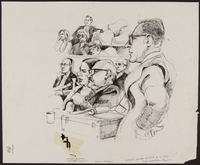
Drawing of lawyer questioning eyewitness at trial of accused Latvian war criminal
Object
Courtroom drawing created by Charles (Hap) Hazard while on assignment for the Baltimore Sun newspaper during the November 1977 deportation trial of Karlis Detlavs held in Baltimore, Maryland. It depicts Detlavs's lawyer questioning an unseen person, while standing next to a seated Detlavs and his daughter in a crowded courtroom. Detlavs was accused of withholding information on his petition for permanent residency by denying involvement in Nazi war crimes during World War II (1939-1945). He was accused of executing Jews in the Riga ghetto and selecting Jews for execution in the Dwinsk ghetto in 1943, while a member of the Latvian Auxiliary Security Police during the German occupation. In 1950, Detlavs emigrated from Munich, Germany, as displaced refugee, with his pregnant wife and young daughter. The family immigrated to the United States and settled in Baltimore. In October 1976, the Office of Special Investigations, US Department of Justice, accused Detlavs of war crimes and the US Immigration and Naturalization Service (INS) filed a deportation action. After four days of hearings, the Honorable Martin J. Travers, the federal immigration judge for the case, announced a continuance so the prosecution could obtain more evidence from Soviet sources. In June 1978, while Judge Travers was on assignment in the US Virgin Islands, part of his circuit at the time, he was stabbed to death. New hearings in the Detlavs trial were held in November 1978 and January 1979. While Detlavs admitted being a member of the Latvian Legion, he denied committing any crimes. Judge Emil Bobek denounced Detlavs for his lack of credibility, but ruled that the identification of Detlavs as a perpetrator was not reliable and a lie was not enough to warrant deportation. The ruling was upheld on appeal.
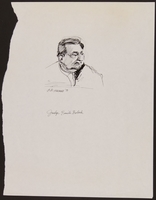
Drawing of judge at trial of suspected Latvian war criminal
Object
Courtroom drawing depicting Judge Emil Bobek created by Charles (Hap) Hazard while on assignment for the Baltimore Sun newspaper during the 1979 deportation trial of Karlis Detlavs held in Baltimore, Maryland. Detlavs was accused of withholding information on his petition for permanent residency by denying involvement in Nazi war crimes during World War II (1939-1945). He was accused of executing Jews in the Riga ghetto and selecting Jews for execution in the Dwinsk ghetto in 1943, while a member of the Latvian Auxiliary Security Police during the German occupation. In 1950, Detlavs emigrated from Munich, Germany, as displaced refugee, with his pregnant wife and young daughter. The family immigrated to the United States and settled in Baltimore. In October 1976, the Office of Special Investigations, US Department of Justice, accused Detlavs of war crimes and the US Immigration and Naturalization Service (INS) filed a deportation action. In November 1977, after four days of hearings, the Honorable Martin J. Travers, the federal immigration judge for the case at the time, announced a continuance so the prosecution could obtain more evidence from Soviet sources. In June 1978, while Judge Travers was on assignment in the US Virgin Islands, part of his circuit at the time, he was stabbed to death. New hearings in the Detlavs trial were held in November 1978 and January 1979. While Detlavs admitted being a member of the Latvian Legion, he denied committing any crimes. Judge Emil Bobek denounced Detlavs for his lack of credibility, but ruled that the identification of Detlavs as a perpetrator was not reliable and a lie was not enough to warrant deportation. The ruling was upheld on appeal.
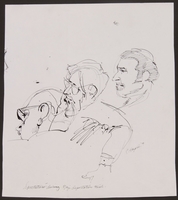
Sketch of three spectators at trial of accused Latvian war criminal
Object
Courtroom drawing created by Charles (Hap) Hazard while on assignment for the Baltimore Sun newspaper during the 1979 deportation trial of Karlis Detlavs held in Baltimore, Maryland. The drawing depicts three courtroom spectators, including a man wearing a kippah. Detlavs was accused of withholding information on his petition for permanent residency by denying involvement in Nazi war crimes during World War II (1939-1945). He was accused of executing Jews in the Riga ghetto and selecting Jews for execution in the Dwinsk ghetto in 1943, while a member of the Latvian Auxiliary Security Police during the German occupation. In 1950, Detlavs emigrated from Munich, Germany, as displaced refugee, with his pregnant wife and young daughter. The family immigrated to the United States and settled in Baltimore. In October 1976, the Office of Special Investigations, US Department of Justice, accused Detlavs of war crimes and the US Immigration and Naturalization Service (INS) filed a deportation action. In November 1977, after four days of hearings, the Honorable Martin J. Travers, the federal immigration judge for the case at the time, announced a continuance so the prosecution could obtain more evidence from Soviet sources. In June 1978, while Judge Travers was on assignment in the US Virgin Islands, part of his circuit at the time, he was stabbed to death. New hearings in the Detlavs trial were held in November 1978 and January 1979. While Detlavs admitted being a member of the Latvian Legion, he denied committing any crimes. Judge Emil Bobek denounced Detlavs for his lack of credibility, but ruled that the identification of Detlavs as a perpetrator was not reliable and a lie was not enough to warrant deportation. The ruling was upheld on appeal.
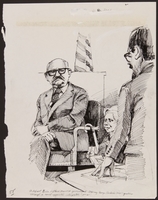
Drawing of defendant and US attorney at trial of suspected Latvian war criminal
Object
Courtroom drawing created by Charles (Hap) Hazard while on assignment for the Baltimore Sun newspaper during the 1979 deportation trial of Karlis Detlavs held in Baltimore, Maryland. The drawing depicts Detlavs on the witness stand begin questioned by United States attorney George Parker through a court-appointed Latvian interpreter. Detlavs was accused of withholding information on his petition for permanent residency by denying involvement in Nazi war crimes during World War II (1939-1945). He was accused of executing Jews in the Riga ghetto and selecting Jews for execution in the Dwinsk ghetto in 1943, while a member of the Latvian Auxiliary Security Police during the German occupation. In 1950, Detlavs emigrated from Munich, Germany, as displaced refugee, with his pregnant wife and young daughter. The family immigrated to the United States and settled in Baltimore. In October 1976, the Office of Special Investigations, US Department of Justice, accused Detlavs of war crimes and the US Immigration and Naturalization Service (INS) filed a deportation action. In November 1977, after four days of hearings, the Honorable Martin J. Travers, the federal immigration judge for the case at the time, announced a continuance so the prosecution could obtain more evidence from Soviet sources. In June 1978, while Judge Travers was on assignment in the US Virgin Islands, part of his circuit at the time, he was stabbed to death. New hearings in the Detlavs trial were held in November 1978 and January 1979. While Detlavs admitted being a member of the Latvian Legion, he denied committing any crimes. Judge Emil Bobek denounced Detlavs for his lack of credibility, but ruled that the identification of Detlavs as a perpetrator was not reliable and a lie was not enough to warrant deportation. The ruling was upheld on appeal.
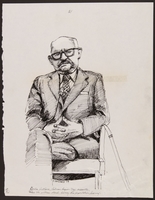
Drawing of accused Latvian war criminal on the stand
Object
Courtroom drawing created by Charles (Hap) Hazard while on assignment for the Baltimore Sun newspaper during the 1979 deportation trial of Karlis Detlavs held in Baltimore, Maryland. It depicts defendant Karlis Detlavs on the witness stand. Detlavs was accused of withholding information on his petition for permanent residency by denying involvement in Nazi war crimes during World War II (1939-1945). He was accused of executing Jews in the Riga ghetto and selecting Jews for execution in the Dwinsk ghetto in 1943, while a member of the Latvian Auxiliary Security Police during the German occupation. In 1950, Detlavs emigrated from Munich, Germany, as displaced refugee, with his pregnant wife and young daughter. The family immigrated to the United States and settled in Baltimore. In October 1976, the Office of Special Investigations, US Department of Justice, accused Detlavs of war crimes and the US Immigration and Naturalization Service (INS) filed a deportation action. In November 1977, after four days of hearings, the Honorable Martin J. Travers, the federal immigration judge for the case at the time, announced a continuance so the prosecution could obtain more evidence from Soviet sources. In June 1978, while Judge Travers was on assignment in the US Virgin Islands, part of his circuit at the time, he was stabbed to death. New hearings in the Detlavs trial were held in November 1978 and January 1979. While Detlavs admitted being a member of the Latvian Legion, he denied committing any crimes. Judge Emil Bobek denounced Detlavs for his lack of credibility, but ruled that the identification of Detlavs as a perpetrator was not reliable and a lie was not enough to warrant deportation. The ruling was upheld on appeal.
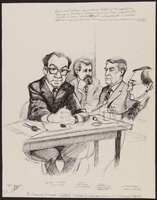
Double sided drawing of expert witness at trial of suspected Ukrainian war criminal
Object
Two sided drawing of Raul Hilberg, government's opening witness, created by Charles (Hap) Hazard at the deportation trial of George Theodorovich in 1985 in Baltimore, Maryland. In August 1983, the OSI brought charges against Theodorovich for killing unarmed Jews. Theodorovich was stripped of his US citizenship in 1984. His disappeared from his home and was the subject of a federal manhunt. After his capture in Philadelphia, he was tried for moral turpitude and failure to disclose wartine activities. In 1987, Theodorovich was found guilty and ordered deported in 1988 because of his involvement in the murder of Jews in Lvov, Poland (Lviv, Ukraine) during the Holocaust. The US wished to deport him to the Soviet Union, but a deportee has the right to choose the country to which his is deported, although that country must agree to accept him. In December 1988, Theodorovich deported himself to Paraguay. At the time, he was the 26th person to receive a deportation order from the US government as a result of investigations and prosecutions by the OSI, Office of Special Investigations, US Department of Justice. The OSI pursued prosecutions in order to deny Nazis and war criminals a safe haven in the US. Hilberg opened the proceedings by describing how Ukrainian police cooperated with the Germans in the round-up of Jews in Lvov and how a community of 130,000 was reduced to 1000. Hilberg was a world renowned scholar, who published the first comprehensive study of the Holocaust and initiated the academic study of the Holocaust. Hazard was assigned to cover the trial and create courtroom drawings for the Baltimore Sun.



